Esch-sur-Alzette, the cross-border area in the south of Luxembourg, is in transformation: a former steel industry region will transform into a center for future-oriented knowledge and innovative creativity. Esch2022 — European Capital of Culture invited Ars Electronica Export to become part of this transformation through curating an exhibition in the Möllerei. The exhibition will invite visitors to explore art as a tool for us humans to understand and envision the future.
Type: Exhibition
Opening: September 2, 2022
Duration: September 3 – November 27, 2022
City, Country: Esch-sur-Alzette, Luxembourg
Venue: Möllerei, 3 avenue des Haut-Fourneaux, L-4362, Esch-sur-Alzette

Artist Portraits
In the exhibition IN TRANSFER – A New Condition, Ars Electronica present artists operating where art, technology and society intersect, artists who are always in places where transformation is happening. One part of the exhibition was dedicated to Artist Portraits, an area that allowed the artists to share some of their thoughts, practices, encounters, and collaborations that led to where they are today.

ARTIFICIAL INTELLIGENCE: USE AND IMPACT IN ART-MAKING TODAY Esch2022 – European Capital of Culture
Leading artists and curators discuss the use and impact of Artificial Intelligence in the process of art-making today and the new creative horizon opened by this technology. Panellists include leading digital artists Špela Petrič, Tristan Schulze and curators Sabine Himmelsbach (HEK), Anett Holzheid (ZKM), Boris Magrini (HEK) and Laura Welzenbach (Ars Electronica).
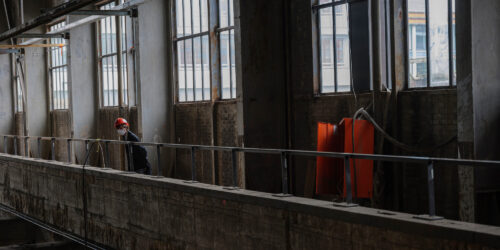
Esch2022 — European Capital of Culture @ Ars Electronica Festival
Esch2022 — European Capital of Culture invited Ars Electronica Export to become part of this transformation through curating an exhibition in the Möllerei. The exhibition will invite visitors to explore art as a tool for us humans to understand and envision the future.
The Möllerei is starting point of our story and a monument of a world order in transition. This former steelwork is transforming itself into a place for culture and art. The surrounding industrial area right on the border of Luxemburg and France is becoming a new district, a place for people. It is about transformation and change. These are the attributes that Ars Electronica is highlighting in the exhibition IN TRANSFER – A New Condition. It approaches these concepts and wants to explore what the nature of change is. What are the issues compelling us to change as a society and which ones are in urgent need of change? What are the mechanisms that drive change, why is it prevented, by what means can it be accomplished? And what role can art play in this?
If we take a brief look at the daily press, it quickly becomes clear how great the everyday complexity of existence has become and what contradictions result from it: the cruel war against Ukraine initiated by Russia, the increasingly dramatic climate change, the pandemic, the issue of exclusion and minorities, the question of distribution, energy, and resources; also, the question of culture in the digital realm, the digital transformation and ethics for artificial intelligence. The dramatic need for action inherent in all these issues, together with the elementary and existential dimension of these challenges, requires a renegotiation of the present that makes commonality and collaboration indispensable. The difficulty of responding to these contradictions reveals social tendencies that polarise and exclude. How can we recognise change not as compromise, provocation, or personal limitation, but as quality, skill, and empowerment? Can art play a role in this? Certainly not in the sense of overall responsibility. But art can try to offer a space, an alternative, a neutral place, in which change in its contradictory complexity can be experienced. Art and culture can thus represent an offer to society, an artistic, social laboratory in which reality and the future are simulated. In this way, it offers a space of experience that takes on the issues that force us to make fundamental changes, but which also has the quality of being a guide for change itself.
In the exhibition IN TRANSFER – A New Condition, we present artists operating in the space where art, technology and society intersect, artists who are always in the places where transformation is happening. In the exhibition, visitors will meet a generation of artists who, as citizens of this world, wish to contribute a perspective that can help us make farsighted decisions.
Artworks
masharu (NL/RU)
The Museum of Edible Earth
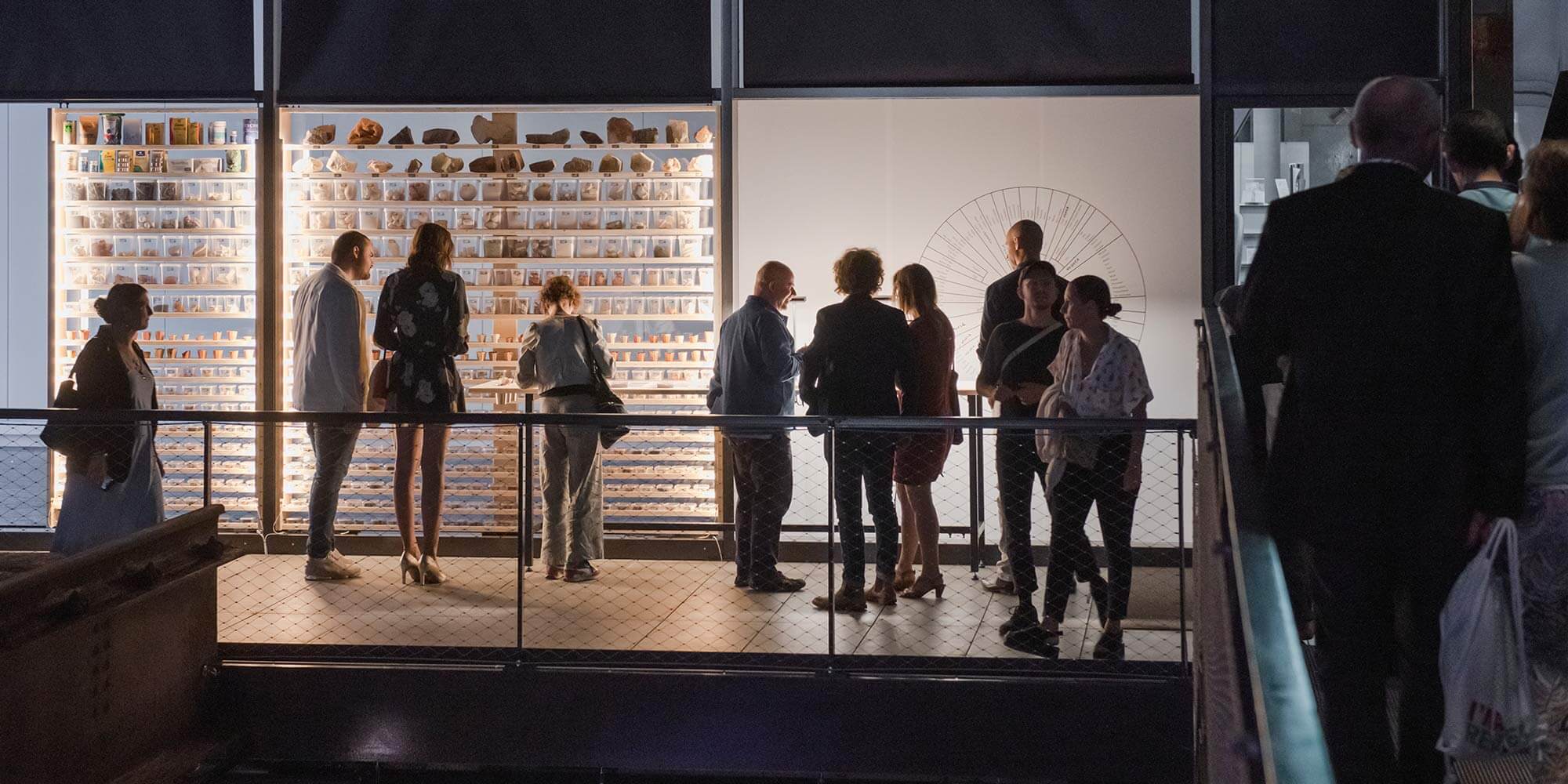
“Geophagy” is the scientific name for the practice of eating earth and earth-like substances such as clay and chalk. Eating earth is an ancient practice and is an integral part of many cultures all over the world. The Museum of Edible Earth is a cross-disciplinary project with a core collection of earth samples which are eaten for several reasons by different people across the globe. It invites the audience to physically question our relationship to the environment and the Earth as well as to review our knowledge about food and cultural traditions. The project addresses questions like: What stands behind earth-eating traditions? Where does the edible earth come from? What are the possible benefits and dangers of eating earth? What engagement are we as humans establishing with our environment and non-humans? The Museum of Edible Earth consists of more than 400 samples originating from 34 countries, for example many types of clay, such as kaolin and bentonite.
Eating earth is not recommended by food authorities and is at your own risk.
Biography
masharu (NL/RU), born in Moscow, lives and works in Amsterdam. masharu is an earth eater and an earth lover. masharu’s projects combine scientific research with a personal approach and traditional practices. In 2011 they obtained a PhD in Mathematics from Eindhoven University of Technology and graduated with honors from Photo Academy Amsterdam. In 2013-2014 they were Artist-in-Residence at Rijksakademie van Beeldende Kunst in Amsterdam. In 2018 masharu was an artist fellow at the Netherlands Institute for Advanced Study in the Humanities and Social Sciences (NIAS-KNAW).
Artwork Credits & Acknowledgement
Founder: masharu; Project management (2020-2022): SasaHara; Photo and video (2021-2022): masharu, Anna Zamanipoor, Luuk Van Veen, Jester van Schuylenburch, Jhalisa Rens; Graphic design (2021-2022): Olga Ganzha, Jhalisa Rhens, Luuk Van Veen; Web and database design: Raphaël Pia, William Ageneau, Marina Pankratova, Andrew Revinsky, Pan Vanitcharoenthum; Product design: Basse Stittgen
The Museum of Edible Earth is supported by the Creative Industries Fund NL, Stichting Niemeijer Fonds, Pauwhof fonds and Prins Bernhard Cultuurfonds Tijl Fonds. The work of masharu is supported by the Mondriaan Fund.
Tega Brain (AU), Julian Oliver (NZ), and Bengt Sjölén (SE)
Asunder
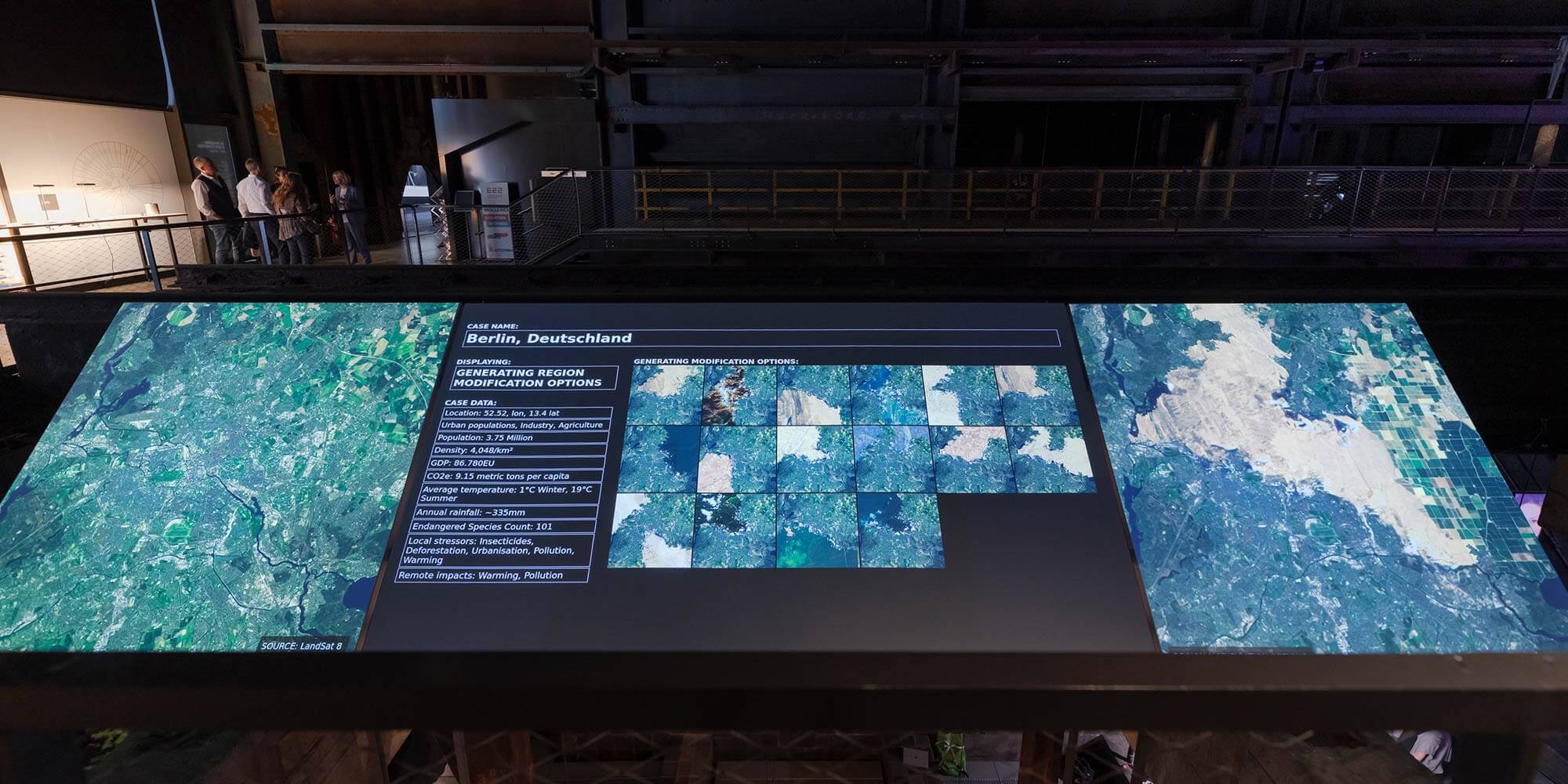
Asunder intends to question assumptions of computational neutrality, our increasingly desperate reach for technology-driven fixes to planetary challenges, and the broader ideological framing of environment as a system. More specifically, it responds to the growing interest in the application of artificial intelligence to solving critical environmental challenges. Taking this approach literally, the project combines state of the art climate and environmental simulation technology, a super-computer and machine learning techniques. The result is a fictional “environmental manager” that proposes and simulates future modifications to the planet by using data on climate, geology, biodiversity, and topography for a series of regions. Although the intention is to prevent harm and stay safely within planetary boundaries, the suggestions are often completely unacceptable, even absurd. As cities are relocated, nations combined, or rivers moved, the work shifts from humorous to preposterous, and from uncannily eco-fetishistic to tediously bureaucratic.
Biographies
Tega Brain (AU) is an Australian born artist and environmental engineer whose work examines issues of data, ecology and infrastructure.
Julian Oliver (NZ) is a critical engineer, artist and activist based in Berlin.
Bengt Sjölén (SE) is an independent software and hardware designer/hacker/artist based in Stockholm, with roots in the home computer demo scene.
Artwork Credits & Acknowledgement
Commissioned by the MAK for the VIENNA BIENNALE 2019
Cod.Act, André Décosterd (CH), and Michel Décosterd (CH)
Cycloïd-E

The starting point for Cycloïd-E was a desire to approach the undulatory movements of pendulums and how they could be set against the development of sound waves. But what if this “pendulum” was made up of horizontally articulated segments? What if a motor replaced the gravitational effect? The segments of the pendulum became metallic tubes equipped with sound sources and measuring devices to enable them to resonate according to their rotations. This sets off a series of unexpected movements.
The balance in the energy exchanges between the segments is almost perfect. Also, the trajectories are surprisingly right and natural. Together, this creates harmony. Through its fascinating and hypnotic dance, Cycloïd-E delineates the space of sound orbits and creates a unique kinetic and polyphonic work.
Biographies
Michel Décosterd (CH) is a plastic artist. He started out with photography and kinetic devices which produced moving images from light and translucent material. After leaving this field he acquired more competencies in material technology and mechanics. Currently, he focuses his plastic research on machines and on movement in particular to build kinetic sculptures.
André Décosterd (CH) is a musician and composer. He specialises in computer programming of musical applications. His studies focus on composition systems specific to electroacoustic and contemporary music, in particular algorithmic composition.
Artwork Credits & Acknowledgement
Ville de la Chaux-de-Fonds, Etat de Neuchâtel, Loterie Romande, Fondation culturelle de la Banque Cantonale Neuchâteloise, Tech-Laser Sandoz SA, Stürm AG, Hydrel GmbH
Quayola (IT/UK)
Remains

Remains is an ongoing project focusing on nature and the tradition of landscape paintings. High-precision laser scanners are used to capture natural landscapes at vast resolutions, resulting in complex digital renderings printed on large-format archival paper.
The combination of highly detailed geometric reconstructions and the imperfections of the 3D-scanning process create hybrid formations, somewhere in between the real and the artificial.
While recreating similar conditions to “en plein air” (outdoor) painters of the late 19th century, the natural landscapes are actually observed and analysed through extensive technological apparatuses, and re-purposed through new modes of visual synthesis.
Biography
Quayola (IT/UK) employs technology as a lens to explore the tensions and equilibriums between seemingly opposing forces: real and artificial, old and new. Constructing immersive installations, he engages with and re-imagines canonical imagery through contemporary technology. Landscape painting and classical iconography are some of the historical aesthetics referenced in Quayola’s work. His varied practice, all deriving from custom computer software, also includes audiovisual performance and sculpture.
Agnes Meyer-Brandis (DE)
One Tree ID − How To Become A Tree For Another Tree

One Tree ID condenses the identity of a specific tree into a complex perfume that can be experienced by human visitors to apprehend the tree’s communication system at a biochemical level. By applying it, people can invisibly wear characteristics of the tree they are standing next to. They can also use parts of its communication system and potentially have a conversation. Although invisible and inaudible by nature, the conversation might still take place on the biochemical level that plants use for information exchange.
The artist aims at creating empathy and suggests an exploration of how to question the way we use our senses to generate new connections and interactions between species. Like humans, trees and plants also have their individual odour. One Tree ID’s perfumes offer alternative ways to exchange information with the plant kingdom upon which humankind depends.
Plants emit and communicate via Volatile Organic Compounds (VOC) – gases and molecules that contribute to cloud formation, which we recognise as the fragrance of a forest. These emissions are specific to each individual plant. Each tree generates its own cloud. The roots and its bacteria, the tree stem and needles emit different VOCs, which have been measured separately by Meyer-Brandis and her scientific partners. For the perfumes on display, the artist has collaborated with a professional perfumer to smell the tree, to compare the collected machine data and nose data to result in the “Cloud of the Roots,” “Cloud of the Tree Stem,” and “Cloud of the Tree Crown,” which then led to the synthesis of a singular One Tree ID perfume.
Biography
Agnes Meyer-Brandis (DE) is a Berlin-based artist with a background in sculpture and new media. She creates works on the fringes of science, fiction and fabulation. Educated first in mineralogy, followed by studies at the art academies in Maastricht, Düsseldorf, and Cologne, she has been the founder and director of the Research Raft, an Institute for Art and Subjective Science that purposefully “is asking questions but gives no answers” in fields such as climate research, environmental studies, meteorology, as well as synthetic and artistic biology. Meyer-Brandis’ work has been exhibited worldwide and awarded many prizes, including a Prix Ars Electronica Award of Distinction, and the European Kairos prize.
Artwork Credits & Acknowledgement
“One Tree ID – Larix kaempferi” was realised in collaboration with Jean-François Hausman and Kjell Sergeanten of the Plant Biotechnologies research group of the Luxembourg Institute of Science and Technology (LIST) and Marc vom Ende, Senior Perfumer, Symrise. In the scope of the Ars Electronica exhibition – Esch Cultural Capital 2022.
REMIX EcoDesign (ES)
Remix EcoDesign
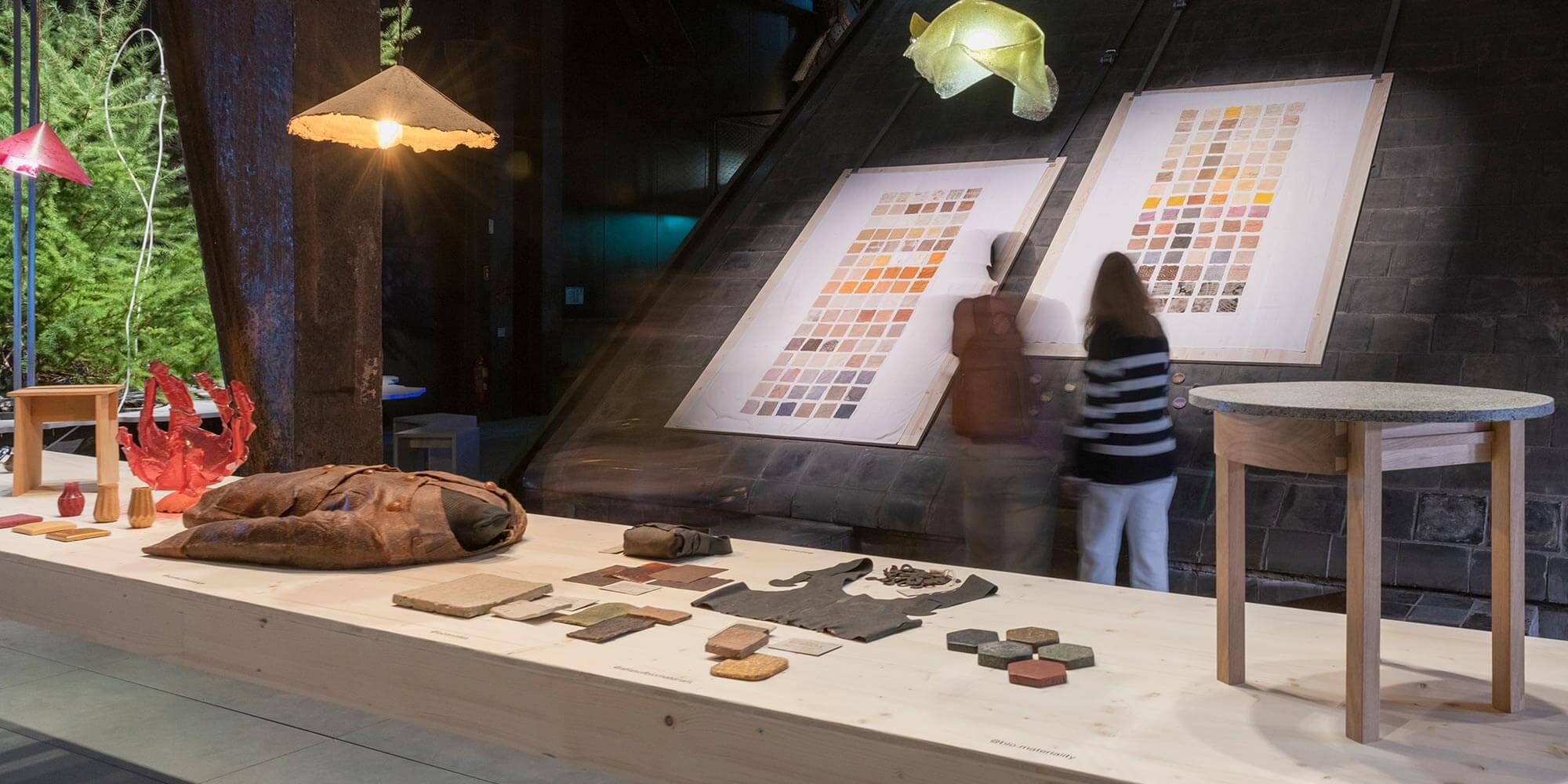
REMIX EcoDesign works with natural dyeing, moulding, 3D printing, laser cutting and other digital fabrication techniques, through co-creation and design-driven material innovation. Beyond the exhibition, REMIX EcoDesign has transformed into a collective that explores circularity, not only by creating materials with olive pits and avocados, coffee peels, vegetable and fruit skins or restaurant waste, but also by exploring collaboration, inclusivity and self-management towards shared knowledge with local actors. The collective behind this project believes that mapping the local neighbourhood resources, socialising technologies and empowering citizens with open knowledge and horizontal co-creation methodologies, are the solution for closing circular waste streams that add value while educating people on environmental impact. The project created a local impact in district scale through the synergies and connections of diverse stakeholders and a global impact through the knowledge transfer and open-source culture promoted through the online tutorials.
Biography
Remix EcoDesign (ES) is a collective of designers and supporters of the local and circular economy that proposes a new productive paradigm. They advocate for the collection and processing of food waste, in order to upcycle it into biomaterials. Through artisanal techniques and digital manufacturing, the materials are shaped into new sustainable products, services, and artistic projects as an alternative for consumption and coexistence.
The development of the projects is the result of a pilot program for conducting a local circular economy at neighbourhood scale of the district of Poblenou in Barcelona, where various designers were incubated in IAAC Fab Lab Barcelona.
Artwork Credits & Acknowledgement
en(des)uso by Lara Campos, KOFI paper by Dihue Miguens, Reolivar by Nailfactory Lab, Squeeze the Orange by Susana Jurado & Elisenda Jaquemot, Biopantone by Anastasia Pistofidou in co-creation with Fabricademy Alumni
Špela Petrič (SI)
Institute for Inconspicuous Languages: Reading Lips

The journal Science recently published an article in which scientists described the first meaningful exchange between a ficus tree and a human being that could, in a broader sense, be considered a conversation. The insightfully envisioned experiment required utmost patience and full commitment from both parties: over the course of eighteen years (2025-43), the young ficus tree (Ficus benjamina) and the human had to negotiate a shared code of signs. The linguist and polyglot M.L. began the experiment by establishing a basic set of communication signs. Like all plants, ficus trees maintain rigorous control over the amount of water they absorb through the roots by opening and closing leaf pores. Each ficus leaf has thousands of such tiny openings, called stomata. M.L.’s idea was to read stomata just as people who can read lips.
In the first four years of the experiment, using the Pavlovian conditioning method, M.L. could teach the ficus tree the basic signs for “more,” “less,” and “stop,” adjusting the level of light according to the openness of its mouths on the underside of each leaf. If the change was too rapid, causing the ficus tree to drop its leaves as these plants often do, the new leaves would remember the code. In the following fourteen years, M.L. and the ficus tree perfected the code of light and lips to the extent that this could be deemed the first scientifically recorded conversation between a plant and a human.
Institute for Inconspicuous Languages: Reading Lips is an attempt to repeat this experiment.
spelapetric.org/institute-for-inconspicuous-languages
Biography
Špela Petrič (SI) is a Slovenian new media artist with a background in the natural sciences, currently a researcher at Vrije Universiteit Amsterdam (biophysics of photosynthesis research group), VU Artscience laboratory hybrid forms. Her artistic practice combines biomedia practices and performativity to enact strange relations between bodies that reveal the underpinnings of our (bio)technological societies and to propose alternatives. Petrič has received several awards, such as the White Aphroid for outstanding artistic achievement (Slovenia), the Bioart and Design Award (Netherlands), and an Award of Distinction at Prix Ars Electronica (Austria).
Artwork Credits & Acknowledgement
Author: Špela Petrič |Programming and sensor integration: Bart Peeters | Programming of the computer vision: Klara Nosan, Tim Oblak | Expert advice: Luka Šajn, Žiga Emeršič, Miha Turšič | Technical execution: Scenart| Special thanks: Faculty of Computer and Information Science at the University of Ljubljana and Waag, NL | The project is a part of ‚European ARTificial Intelligence Lab‘. Co-funded by: Creative Europe programme of the European Union, Ministry of Culture of the Republic of Slovenia and Department of Culture of the Municipality of Ljubljana.
h.o (INT)
What a Ghost Dreams Of

What is a “ghost”? Generally, it is understood as an inner “soul” and a mysterious outward appearance. What a Ghost Dreams Of grapples with a new “ghost” of our time: digital surveillance in our society. Here in the booth, visitors are recorded by computer vision and the images are fed directly into a “ghost” that creates new digital faces of people who do not exist in the real world. These “new” faces are subsequently displayed on screen in the hall. We must ask ourselves as humans, what we are projecting into the digital counterpart we are creating with artificial intelligence (AI). After all, it is getting to know our world without prior knowledge and generates data that never existed. Furthermore, What a Ghost Dreams Of raises questions like: What are the effects of using AI to produce works of art? Who holds the copyright? What is AI, the “ghost,” dreaming about when doing so? And ultimately, how are we intending to use AI and what effects will it have on our self-image as human beings?
howeb.org/portfolio-item/what-a-ghost-dreams-of-2019
Biography
h.o (hdoto) (INT) is an international artist group based in Europe, Japan and United States. Under the mission of “Sense the Invisible”, the collective will be realizing experimental and artistic expressions with the speed of technological progress.
Artwork Credits & Acknowledgement
The presentation of this artwork is made possible through the support of the EU-Japan Fest Japan Committee.
AI system: John Brumley; Surveillance application: Hiroshi Chigira; Technical direction: Hiroshi Chigira, John Brumley, Taizo Zushi; Art direction, concept: Hideaki Ogawa, John Brumley, Hiroshi Chigira, Emiko Ogawa, Taizo Zushi; Eye blinks editing / Directing: Martina Sochor; Eye blinks cinematography: Jonatan Salgado Romero; Eye blinks model: Andressa Miyazato; Photograph: Florian Voggeneder; Face photo booth: Ali Nikrang
DISNOVATION.ORG (FR, PL, CA)
LIFE SUPPORT SYSTEM
[ECOSYSTEM SERVICES ESTIMATION EXPERIMENT]

This artistic provocation seeks to estimate the orders of magnitude of critical ecosystem services that are fundamental to all planetary life processes.
It is common to describe our relationships with society, the world, and the biosphere with metaphors from economics, which has specific understandings of value. Today’s prevailing economic conventions are unable to recognise the inherent value of the ecosystems on which all life depends. In cultures overdetermined by concepts from economics, we are left without adequate discursive instruments to address the importance of ecosystem contributions to life on Earth socially or politically.
This experiment consists of 1 square meter of wheat, cultivated in a closed environment. Critical inputs such as water, light, heat, and nutrients are measured, monitored and displayed for the public. This procedure makes the immense scale of ecosystem contributions palpable and provides a speculative reference for a reckoning of the undervalued and over-exploited “work of the biosphere.”
Biography
DISNOVATION.ORG (FR, PL, CA) is a research collective set up in Paris in 2012, whose core members include Maria Roszkowska, Nicolas Maigret, and Baruch Gottlieb. They work at the interface between contemporary art, research, and hacking, and compose tailor-made teams for each investigation together with academics, activists, engineers, and designers. Their recent artistic provocations seek to empower Post Growth imaginaries and practices by challenging the widespread faith that “economic growth” and “technological fixes” will solve the ecosystem disruptions they produced in the first place. They recently co-edited A Bestiary of the Anthropocene, an atlas of anthropic hybrid creatures, and The Pirate Book, an anthology on media piracy. Their works have been exhibited, published, and reviewed worldwide.
Artwork Credits & Acknowledgement
Conception: DISNOVATION.ORG, Baruch Gottlieb; Web Developer: Jérôme Saint-Clair; Prototype Developers: Vivien Roussel, Thomas Demmer; Production: iMAL (BE) | Coproduction: Biennale Chroniques (FR)
Danielle Brathwaite-Shirley (DE/GB)
BLACKTRANSARCHIVE.COM

Traditionally Black Trans people have been misrepresented or absent within archives. BLACKTRANSARCHIVE.COM also known as „We Are Here Because Of Those That are Not“ is an archive built and designed by and for Black Trans people. The archive’s aim was to find a way to more accurately store Black Trans existence. Culminating in an 3D animated game the project preserves the stories of Black Trans people generating a space where our existence cannot be ignored. The piece was designed alongside the artists Ebun Sodipo, Tobi Adebajo and Jacob V Joyce and the contributors. It is assembled and developed from the ground up by a team of Black Trans people drawing on their own lived experience. From these conversations, all characters, landscapes and stories were enfleshed into a breathing resemblance of themselves. In the style of a “Choose Your Own Adventure” and influenced by PS1 games, visitors are required to reveal their own identity in order to access the work. Depending on how you treat the archive, your journey through the work will mirror your treatment of it.
WELCOME TO THE PRO BLACK PRO TRANS ARCHIVE.
You can play the game online at home too:
blacktransarchive.com
Biography
Artist and game developer Danielle Brathwaite-Shirley (DE/GB) weaves the lived experiences of Black Trans people into the fabric of their fictional space. Through animation, sound, and performance, they pay reverence to the many creative narratives of “those living, those who have passed, and those who have been forgotten.” Much like a Black Trans archive, their practice cements the posterity of black trans people. Throughout history, black queer and trans people have been erased from our archives. Because of this, it is necessary not only to archive our existence but also the many creative narratives we have used and continue to use to share our experiences. Danielle Brathwaite-Shirley’s work has been shown in Albright Knox, David Kordansky Gallery, Quad, Arebyte Gallery, Science Gallery, MU, Barbican, Tate, and Les Urbaines, and has been part of the BBZ Alternative Graduate Show at the Copeland Gallery.
www.daniellebrathwaiteshirley.com
Artwork Credits & Acknowledgement
Directed by Danielle Brathwaite-Shirley; Coding: Emily Martinez; Contributors: Danielle Brathwaite-Shirley, Marikiscrycrycry, Pacheanne, Tobi Adebajo, Ebun Sodipo, Bernice Mulenga, Ornella Ospino Blkmoodyboi, Jacob v Joyce, Shay P-W, Zamy, Camus-Doughen, Elijah Che, Travis Alabanza, Raks, Arthur Kibet, Vik, A Marlowe, Christopher; Special thanks to METRO Transcend; Commission by Science Gallery
Adam Harvey (US/DE)
VFRAME: Visual Forensics and Metadata Extraction

VFRAME is a computer vision toolkit designed for human rights researchers. They often rely on videos shared online to document war crimes, atrocities, and human rights violations. Manually reviewing these videos is expensive, does not scale, and can cause vicarious trauma. As an increasing number of videos are posted, a novel approach is needed to understand these large datasets. Therefore, VFRAME makes state-of-the-art artificial intelligence used in the commercial sector accessible to the needs of human rights researchers and investigative journalists.
Most recently, VFRAME designed a computer vision algorithm to analyse videos from Ukraine for evidence of cluster munitions. To detect this munition a computer vision algorithm was trained using a 3D-rendered synthetic dataset. For that, a virtual 3D model of the munition was 3D printed and photographed in staged scenes to create a benchmark dataset. Together, the training and benchmark datasets were used to forge a new algorithm, which detects the cluster munition and helps the conflict zone researchers analysing war crimes in Ukraine.
Biography
Adam Harvey (US/DE) is an artist and research scientist based in Berlin. He focuses on computer vision, privacy, and surveillance. He is a graduate of the Interactive Telecommunications Program at New York University (2010) and is the creator of the VFRAME.io computer vision project, the Exposing.ai dataset project, and the CV Dazzle computer vision camouflage concept. Harvey has worked as an adjunct professor at New York University and School of Visual Arts in NYC, a research fellow at the Künstliche Intelligenz und Medienphilosophie program at Karlsruhe HfG, a digital fellow at the Weizenbaum Institut in Berlin working on Exposing.ai, and currently as an academic technologist for the Karlsruhe HfG AI Forensics project.
Simon Weckert (DE)
Google Maps Hacks

In Google Maps Hacks 99 second-hand smartphones in a handcart are used to generate a virtual traffic jam in Google Maps. With this method, it is possible to turn a green street red on the virtual map, indicating there is a traffic jam in the location in question. But it also has a very real impact on the physical world: cars are navigated on different routes to avoid being stuck in traffic. With its Geo Tools, Google has created a platform that allows users and businesses to interact with maps in a novel way. This means that questions relating to power in the discourse of cartography must be readdressed and raised differently. What is the relationship between the commendable art of enabling people and the techniques of supervision, control, and regulation in Google’s maps? Do these maps determine the behaviour, opinions, and images of living beings by exercising power and control through knowledge?
simonweckert.com/googlemapshacks.html
Biography
Simon Weckert (DE) wants to create a dialog between his artworks and technologies in the process of making and creating. On the one hand, the scenario shows the environment he is working in with technologies as a tool that affect his artworks. On the other hand, he shows how these tools shape and manipulate his creative output. By doing so, he would like to show how machines were introduced to optimise the working processes, save time, or increase accuracy, and open the question of how we became so dependent on them that we often forget what they actually do. Instead of hyping or damning the technology, he would like to invite visitors to reflect on the meaning and modes of existence of technology in a critical and sober way.
Bjørn Karmann (DK), Tore Knudsen (DK)
Project Alias
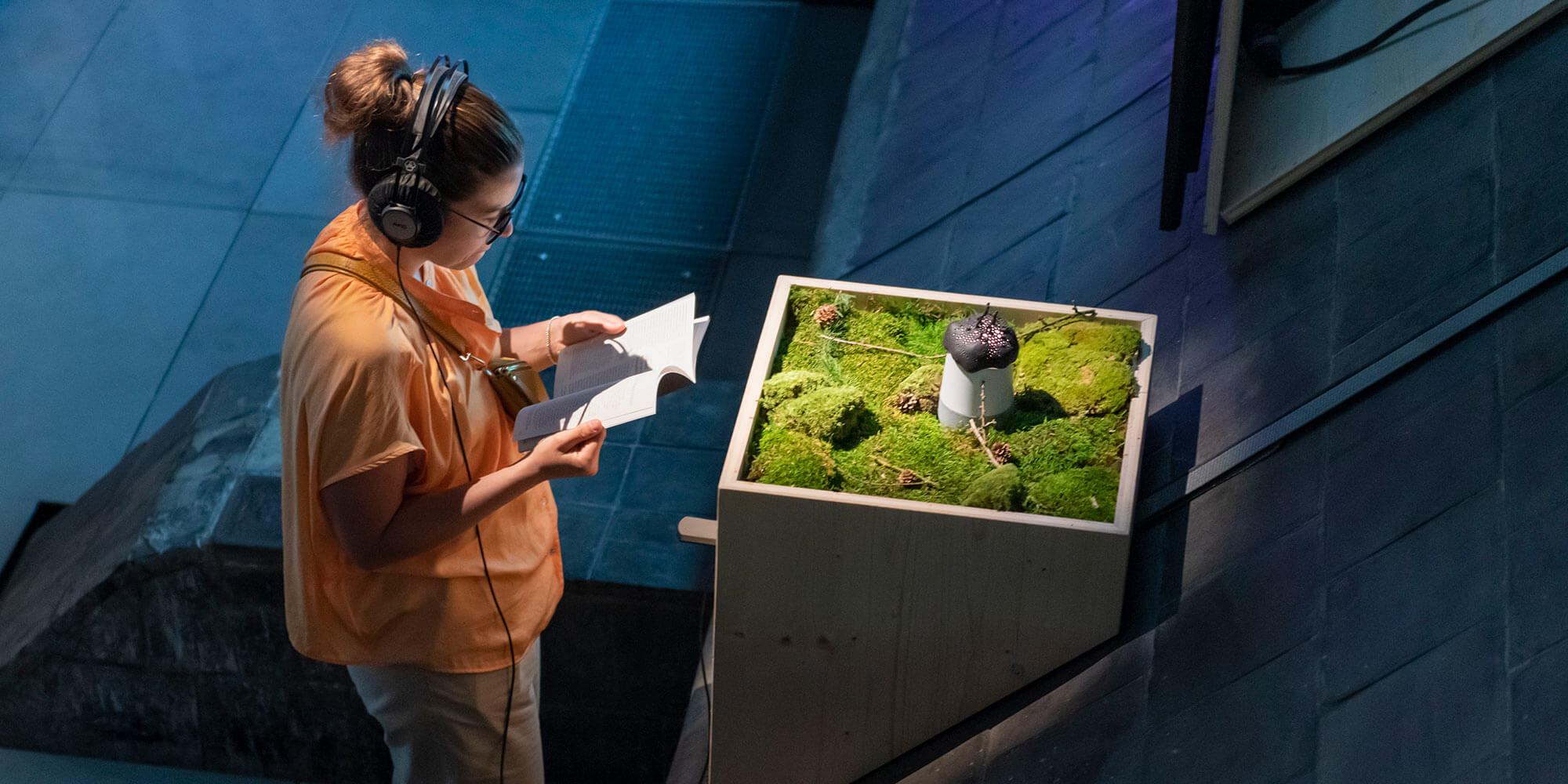
Alias is a teachable “parasite” designed to give users more control over their smart assistants, both in terms of customisation and privacy. Using a simple app, users can train Alias to react to a custom wake word and, once trained, it can take control of the home assistant by activating it for users. Until Alias is activated with the custom wake word it makes sure that the assistant is inactive and unable to listen by interrupting the microphones. In this way, Alias acts as a connecting element that can communicate with the smart assistant and manipulate it when placed on top of it. The entire process works disconnected from the internet, as Alias is equipped with a Raspberry Pi that operates locally to detect the wake word. This project demonstrates how maker culture and open source can be used not only to redefine our relationships with smart home technologies, but also to transfer power and control from companies to end users.
Biographies
Tore Knudsen (DK), Head of Design @ Noodl, Malmö, is a Copenhagen-based designer who currently works with design and strategy at Noodl, a visual programming platform. His personal work is driven by an interest to explore and challenge our relationship with modern technology. In doing so, he has won multiple awards.
Bjørn Karmann (DK) is a Danish designer working at Tellart, Amsterdam. He holds a master’s degree in Interaction Design from the Copenhagen Institute of Interaction Design and a bachelor’s degree in Communication Design from Kolding Design School. Bjørn combines his curiosity for new and emerging technologies with his passion for physical and human interactions, while finding a balance between nature and technology. With experience in design, installation art, robotics, and physical computing, he works across multiple disciplines and manifests between physical and virtual space.
Climate Action Tech (EU/Global)
Branch Magazine: Sustainable and Fairer Internet for Everybody

Branch is an online magazine written by and for people who dream of a sustainable and just internet for all. The internet is the world’s largest fossil fuel-powered machine. If we continue business-as-usual, the IT sector will be responsible for 14% of the world’s carbon emissions by 2040. We believe that the internet must instead serve our collective liberation and ecological sustainability. That is why we created Branch Magazine. The magazine is a space for personal reflection, critical engagement with technology, and experimentation. Branch Magazine articles strive to connect sustainability to root causes and to inequalities experienced at different intersections—gender, race, class, ability, and so on. Creating change requires all kinds of practices, so our contributors include climate activists, open-source technologists, indigenous leaders, artists, energy scientists, and degrowth experts, who are reflecting on the many possible paths towards a sustainable and fairer internet for all. The online magazine is itself a model of this mission—it was not only developed in a resource-saving way, but also adapts its appearance to the current share of renewable energies.
Biography
Climate Action Tech (EU/Global) is a community of practice of tech workers that provides support and guidance for systemic change in our organisations and industries for rapid, far-reaching, and unprecedented change. The climate crisis requires a serious and sustained response from across civil society, and that includes the tech sector and technology professionals. Climate Action Tech’s purpose is to empower technology professionals to play our part—to meet, discuss, learn about, and take climate action. Our vision is that everyone is working on the climate crisis at all levels. Climate Action Tech’s Branch Magazine was honoured with the new Ars Electronica Award for Digital Humanity.
Artwork Credits & Acknowledgement
Managing editor: Michelle Thorne; Editor: Chris Adams; Assistant editors: Laurence Bascle, Carrie Hou; Design: Tom Jarrett; Development: Jack Lenox, Hannah Smith, Chris Adams; Cover illustrations: Hélène Baum, Gica Tam; Web design: Tom Jarrett; Contributors: Maddie Stone, Tom Jarrett, Superflux, Vândria Borari, Camila Nobrega, Gabi Ivens, Michelle Thorne, Joana Moll, Tega Brain, Alex Nathanson, Benedetta Piantella, Eirini Maliaraki.
With support from EIT Climate KIC, Mozilla Foundation, Climate Action Tech, and the Green Web Foundation
Mimi Onuoha and Mother Cyborg (Diana Nucera) (US)
A People’s Guide to AI

Systems that use artificial intelligence (AI) are quietly becoming present in more and more parts of our lives. But what does this technology really mean for people, both right now and in the future?
Written in 2018 by Mimi Onuoha and Diana Nucera, the founders of the non-profit press A People’s Guide to Tech, A People’s Guide to AI is a comprehensive beginner’s guide to understanding AI and other data-driven tech. The guide uses a popular education approach to explore and explain AI-based technologies so that everyone—from youth to seniors, and from non-techies to experts—has the chance to think critically about the kinds of futures automated technologies can bring.
The mission of A People’s Guide to AI is to open up conversation around AI by demystifying, situating, and shifting the narrative about what types of use cases AI can have for everyday people.
Continue reading at home and download the zine for free online
mimionuoha.com/a-peoples-guide-to-ai
Biographies
Mimi Ọnụọha (US) is a Nigerian-American artist and researcher whose work highlights the social relationships and power dynamics behind data collection. Her multimedia practice uses print, code, installation, and video to call attention to the ways in which those in the margins are differently abstracted, represented, and missed by sociotechnical systems.
Mother Cyborg (Diana Nucera) grows out of more than twenty years as a musician, technologist, community organiser and educator. She is motivated by a vision of the future where the greatest possibilities for collective liberation, art, and technology merge. She develops music, art, and educational tools to reveal the complexities that occur where technology intersects with social spaces, economies, and relationships.
Artwork Credits & Acknowledgement
Published by A People’s Guide to Tech, written by Diana Nucera and Mimi Onuoha, illustrated by And Also Too
tranxxeno lab (US)
TX-1
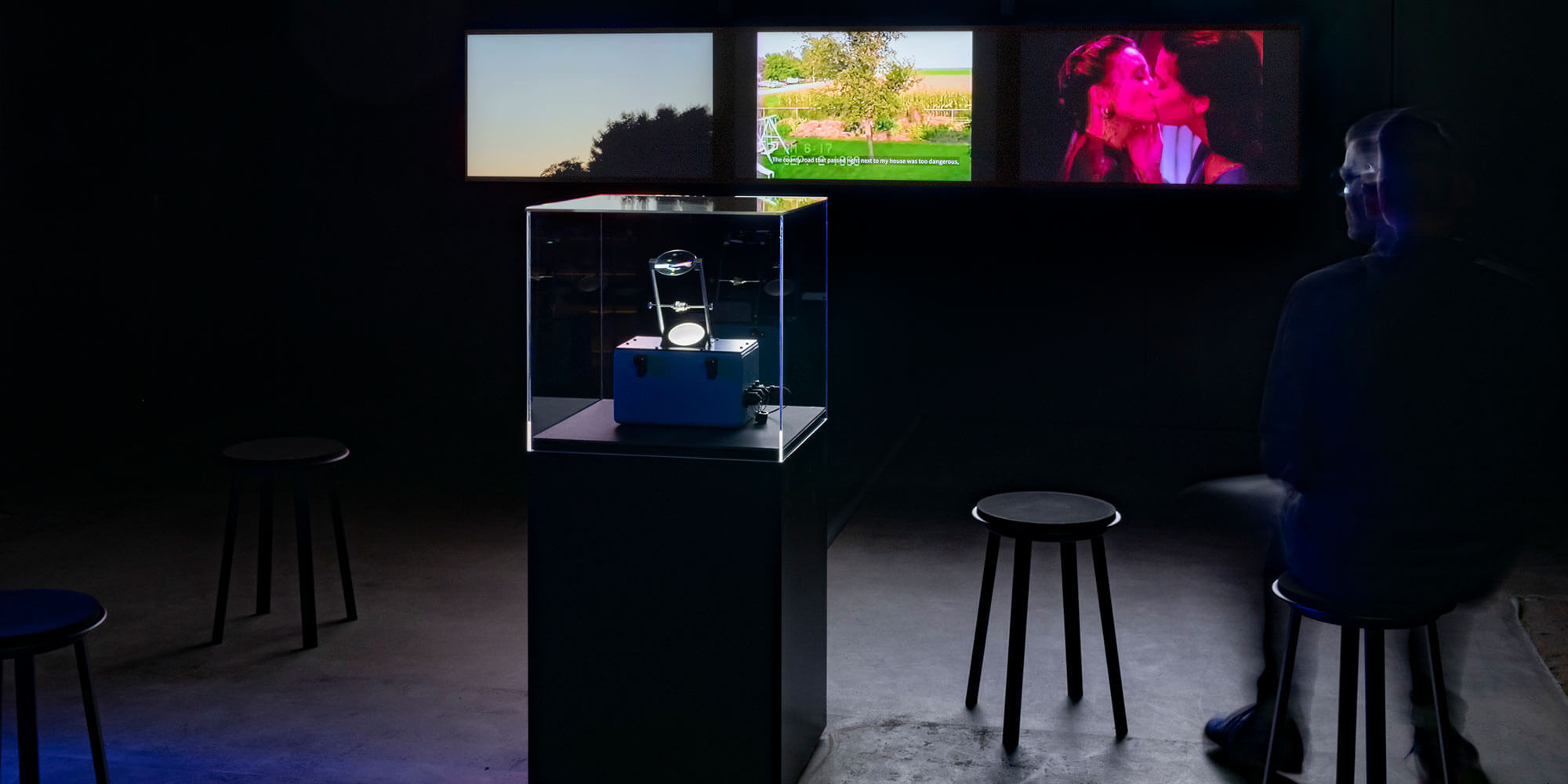
The enchanting Earth is too-often made inhospitable to those marked as transgender. To survive we xenomogrify ourselves through social and biological technologies, altering our surfaces, our viscera, our molecular balances. None of us have been to space even if we possess somatic knowledges of deep bodily transformations, experiences that are necessary for extraterrestrial environments.
TX-1 launched bits of my hormone replacement medications to the International Space Station (ISS), marking the first-known time that elements of the transgender experience orbited the Earth. TX-1 includes a fragment of my spironolactone pill, a slice of my estradiol patch, and a miniature handmade paper sculpture, included to gesture towards the absent-yet-present xenoentities of the cosmos. A symbolic exodus to an orbit high above, the return of TX-1 to Earth was also a sign of resilience, of not being disposed of, of coming back to thrive once again.
TX-1 flew to the ISS as part of the Sojourner 2020 project of the MIT Space Exploration Initiative, which provided the launch opportunity to nine artist-groups who were selected from an international open call. You truly never go to space alone.
While space is, in many ways, one of the most inhospitable places for life, it simultaneously holds an aura—naïve, perhaps—as a place of transformation where the usual constraints of life on earth can be refashioned, where those who are tranxxeno can exist without earthly prejudices. Some early trans* activism even expressed desires for connection with extraterrestrial beings, suggesting kinship predicated on being seen as alien. Such cosmological allies thus evince the yearning for acceptance of the Other. These stories that we tell about space are of course simultaneously stories that we tell about earth, and thus TX-1, in line with this earlier activism, manifests a dream of acceptance of the tranxxeno as we move through these transitioning times.
Biography
tranxxeno lab / Adriana Knouf (US), PhD works as an artist, writer, and xenologist. She engages with topics such as wet media, space art, satellites, radio transmission, non-human encounters, drone flight, queer and trans futurities, machine learning, the voice, and papermaking. She is the founding facilitator of the tranxxenolab, a nomadic artistic research laboratory that promotes entanglements among entities trans and xeno. Adriana regularly presents her artistic research around the world and beyond, including a work that has flown aboard the International Space Station. She was recently a Biofriction artist-in-residence at the Kersnikova Institute in Ljubljana, Slovenia. Adriana is currently an artist-in-residence at Waag in the Netherlands, Amsterdam, as part of the Art4Med project. She lives and works in Amsterdam.
Artwork Credits & Acknowledgement
Concept and fabrication: Adriana Knouf; TX-1 box design and modeling: Felipe Rebolledo; TX-1 was selected through MIT Media Lab Space Exploration Initiative’s first international artwork open call to the ISS and the launch opportunity was provided by the initiative.
Additional support: Northeastern University; Special thanks: Claudia Pederson, Špela Petrič, Miha Turšič
Another Farm (JP)
Modified Paradise: Dress
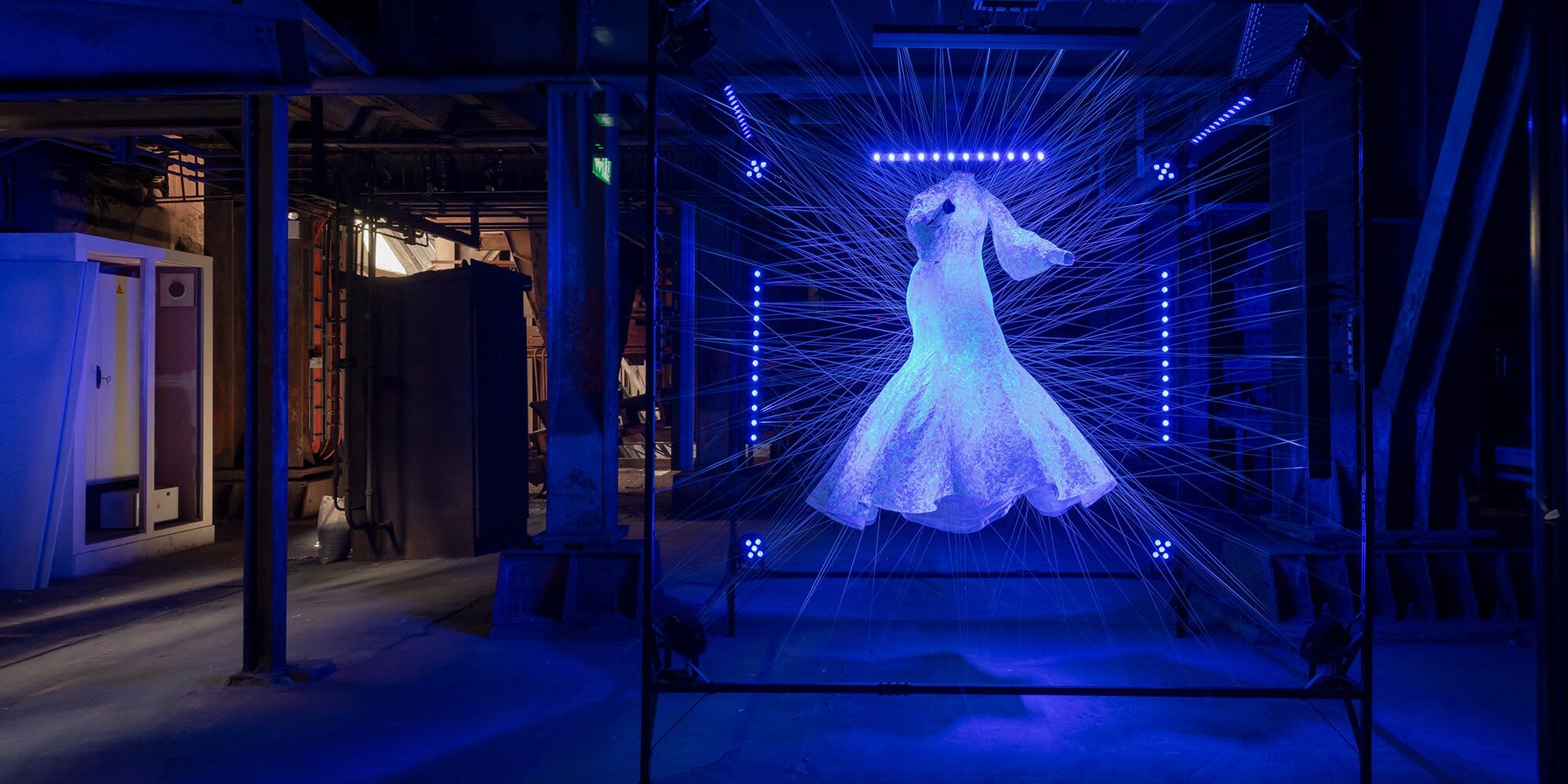
Another Farm works with genetically modified glowing silk to create surreal sculptures that incorporate textiles and traditional handicraft. Glowing silk is created by inserting the GFP gene into silkworms. Advancements in genetic modification today often raise ethical questions and inspire dystopian science fiction. However, silkworms, domesticated animals, livestock, and flora among many other examples, have been genetically modified through controlled or selective breeding for centuries and are often not associated with this topic and its ethical implications. Modified Paradise is a series of sculptures that aim to integrate new and radical technologies with traditional industries that have exploited nature to rethink the boundaries of ethics and humanity’s interaction with nature.
Biography
Another Farm (JP) is a collaborative project between Hiro Ozaki and Masaya Kushino. Working with scientists and engineers, Another Farm explores the relationship between humanity and nature to produce works that bring together new technology and traditional techniques and cultures. Past exhibitions include Nature (2019, Cooper Hewitt Museum, New York), Triennale di Milano (2019), Ars Electronica (2019, Austria), Future and the Arts (2019, Mori Art Museum, Tokyo) and Mode Surreal: A Crazy Love for Wearing (2022, Tokyo Metropolitan Teien Art Museum, Tokyo).
Artwork Credits & Acknowledgement
The presentation of this artwork is made possible through the support of the EU-Japan Fest Japan Committee.
Etsuko Ichihara (JP), ISID OPEN INNOVATION LAB. (JP)
NAMAHAGE in Tokyo

NAMAHAGE in Tokyo is an attempt to reinterpret the functions of traditional deities and folklore and implement these in the city of modern era. Focusing on the contemporary urban relevance of the NAMAHAGE ritual, NAMAHAGE in Tokyo seeks to reconstruct and implement the NAMAHAGE system in a modern city. It translates and reinterprets for the urban context the ritual´s functions, including maintenance of rural community through mutual surveillance, initiation into adulthood, and reinforcement of family bonds.
Making the city their habitat and evolved in adaptation to individual areas like Akihabara, Harajuku, and Sugamo, the “urban NAMAHAGE” identify “bad children” (=adults in need of discipline) in each neighborhood based on the data accumulated by mutual surveillance via social media as well as other networks of surveillance spread across the city. When they emerge on New Year´s Eve, these NAMAHAGE enforce discipline by mind hacking, taking full advantage of sensing and VR technologies and bringing growth, happiness, and blessings to the people of the city.
Biographies
Etsuko Ichihara (JP), born in 1988, is a media artist / fantasy inventor. Etsuko Ichihara has been creating artworks that interpret Japanese culture, customs, and beliefs from a unique point of view, and present new, technology-based approaches. Thanks to their strong impact, these works have been introduced across a wide range of media. Etsuko Ichihara’s “Digital Shaman Project” was included in the Excellence Award at the Japan Media Arts Festival, Honorary Mention in PRIX Ars Electronica 2018 and STARTS Prize Nomination.
etsuko-ichihara.com
ISID OPEN INNOVATION LAB. (JP): In April 2011, ISID established the Open Innovation Lab to collaborate with companies and educational institutions in technology research and service development by making practical use of cutting-edge technologies, including those that are still in experimental phases.
innolab.jp/en
Artwork Credits & Acknowledgement
The presentation of this artwork is made possible through the support of the EU-Japan Fest Japan Committee.
Media Art Director: ICHIHARA Etsuko
Communication Planner: ABE Genki (May Inc.)
Strategist and Manager: HAYAKAWA Yukie
Technical Producer: NOZAKI Kazuhisa
Supervisor: MORITA Hiroshi (ISID OPEN INNOVATION LAB)
Video Original Writing & Planning: ASO Kamo (neconos)
Video Direction and Editing: MATSU Hiroaki (TYO Inc.)
Video Producer: WATANABE Masafumi
Videography Assistant: ISHIBASHI Hiroki
Mask Production of NAMAHAGE in Akihabara: IKEUCHI Hiroto
Costume Production of NAMAHAGE in Akihabara: SUZUKI Junya (chloma)
Costume of NAMAHAGE in Harajuku: chloma
Mask and Costume Production of NAMAHAGE in Sugamo: korotoro NAKASAKA Akiko
UI Visual Design: NAKAMURA Keiichi, YOKOYAMA Naoto (flapper3 Inc.)
Motion Graphic: NAKAMURA Keiichi, YOKOYAMA Naoto (flapper3 Inc.)
Main Theme Song: The Puh「NAMAHAGE LAND」
Logo Design: HATA Yurie
Website Production: CHONO Kaoru (602 inc.)
Cooperation: Oga City, Akita
Production: MAZRI Inc.
This movie is created as a trial research project for the governmental “Basic Policy for Promoting Measures related to Preparations for and Management of the Olympic and Paralympic Games in Tokyo in 2020.
Partner and Venue
Located in Luxembourg’s former steel-mining south and crossing the border into France, Esch2022 – European Capital of Culture aims at promoting the cultural and artistic diversity of the region. The programme comprises a vast array of events from all artistic disciplines with a specific thematic focus on the transition of the region from the industrial past to a contemporary society of knowledge. Media arts and immersive exhibitions developed in collaboration with renowned international institutions are therefore cornerstones of the visual arts programme unfolding in a stunning post-industrial site: Esch-Belval.
esch2022.lu/en/
The Möllerei is a large industrial building originally used to store raw materials (coke and iron ore) before they were fed into the blast furnaces to produce cast iron and slag. With a total length of about 160 meters the Möllerei is a characteristic feature of the former Belval steel plant and local area. Opened to the public in 2018 after extensive transformation work, the North section is now home to the Luxembourg Learning Centre. The South section has recently undergone thorough restoration work. It now connects to the Blast Furnace A via a metal footbridge and accommodates a 500 square meter exhibition space over 3 floors.
Address: Möllerei, 3 avenue des Haut-Fourneaux, L-4362, Esch-sur-Alzette
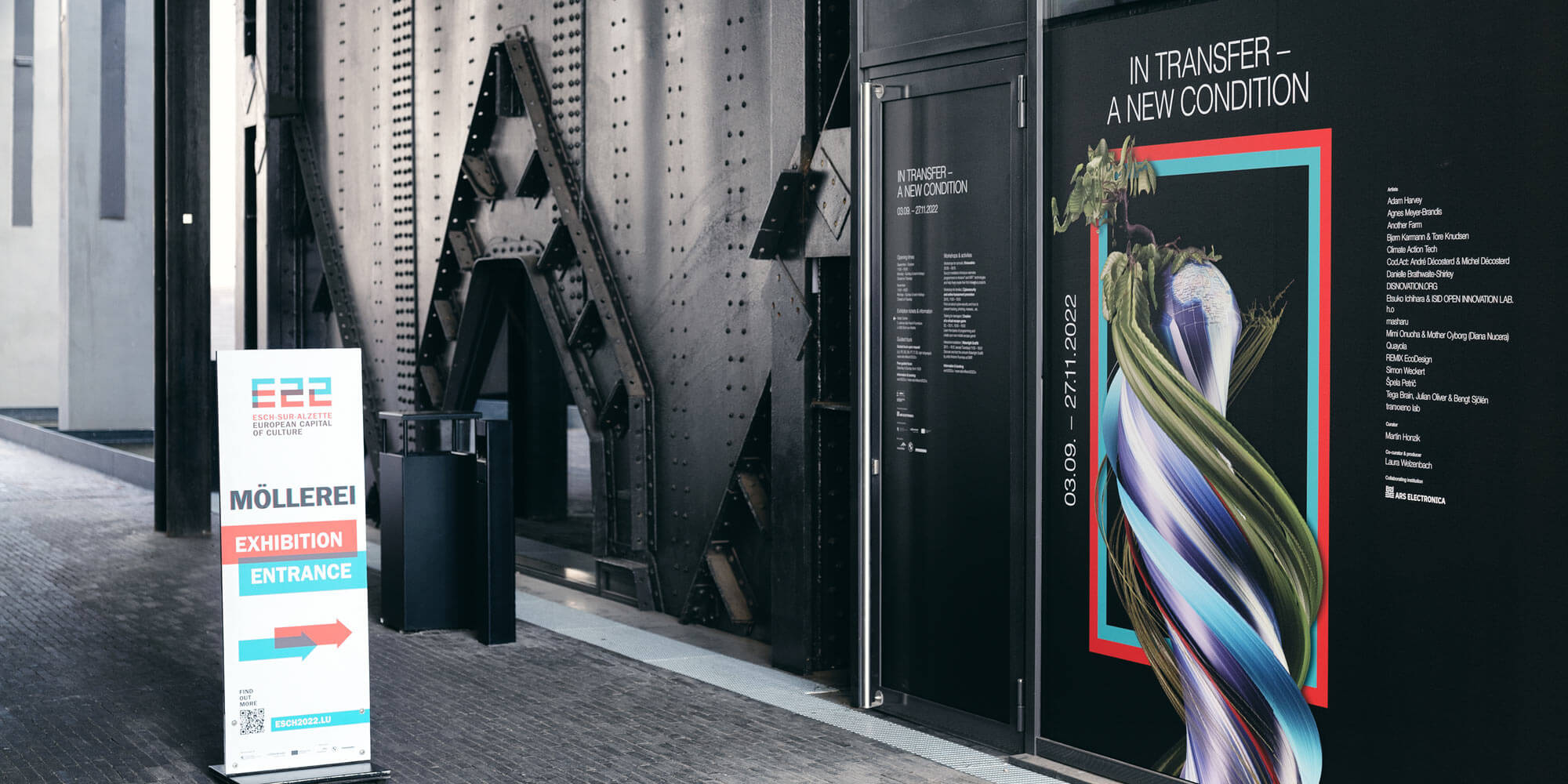
Credits
The exhibitions are organized by Esch2022 — European Capital of Culture in collaboration with ZKM | Center for Art and Media Karlsruhe, HEK (House of Electronic Arts) and Ars Electronica.
Curator: Martin Honzik (Ars Electronica)
Producer and Co-Curator: Laura Welzenbach (Ars Electronica)
Producer: Veronika Krenn (Ars Electronica)
Production and Coordination: Vincent Crapon (Esch2022)
Tech Lead: Thomas Schwab, Klaus Dieterstorfer and Ferenc Hirt (Ars Electronica)
Set-up Team: Uli Okujeni, Martin Pöll, Igor Maier, Heiko Hoos and Marius Nestler
Facility Manager: Guillaume Taens (Esch2022)
Exhibition Design: Jérôme Becker and Uwe Sebastian Brunner
Exhibition Key Visual: MOOI DESIGN
Exhibition Graphic Design: Cropmark
Editor: Alexander Wöran
Proof Reading: Laura Freeburn, Vincent Crapon and Gauthier Lesturgie
Translation: Ingrid Fischer-Schreiber (German) Gauthier Lesturgie (French)
Contractors: Magnum, Artinate Karlsruhe, LuxVisual, Gerriets, Euroline
Mediation Concept: Léa Cheymol, Delphine Harmant, Célia Turmes (Esch2022); Laura Welzenbach (Ars Electronica)
Mediators: Koffi Adzewoda Dikenu, Reyhan Baykara, Oumayma Haddioui, Johan Harmant, Julie Fac, Fadi Jaafar, Zaïneb Mouss, Elena Riolino, Caroline Schmit, Mohamad Shamma, Elie Tomassini, Yixing Tu, Anthony Visconti, Jeanne Wolff
Tour Guides: Mekdes Asefa, Hannah Back, Reyhan Baykara, Julia Buso, Khili Chaima, Tiffany Dhur, Julie Fac, Carla Genicot, Marie-Paule Greisch, Oumayma Haddioui, Johan Harmant, Anna Lisiecki, Isabelle Mattern, Zaïneb Mouss, Georg Riesenhuber, Caroline Schmit, Elie
Special thanks to
The artists of the exhibition and their assistants and supporters
Univ.-Prof. Mag.art. PhD. Manuela Naveau
EU-Japan Fest Japan Committee – supporting Japan-related programs in European Capitals of Culture
Ars Electronica Team: Veronika Liebl, Karl Julian Schmidinger, Karla Spiluttini, Kristina Maurer, Christl Baur, Emiko Ogawa, Katia Kreuzhuber, Martin Hieslmair, Gregor Tatschl, Christopher Sonnleitner, Robert Bauernhansl
The Esch2022 Team: Maëlle Berthelemy, Léa Cheymol, Delphine Harmant, Dany Lucas, Alexandre de Muyser, Jessika Rauch, Célia Turmes, Patrick Weber
The Möllerei Collaborators: Vincent Crapon, Yulia Fisch, Matthias Gommel, Sabine Himmelsbach, Anett Holzheid, Boris Magrini, Françoise Poos, Thomas Schwab, Guillaume Taens, Peter Weibel
Le Fonds Belval: Daniela Di Santo, Stephane Frieres, Charlotte Moulaert, Elisabete Nuno, Lucio Wercollier
Esch2022 – European Capital of Culture
Chairman: Georges Mischo
General Director: Nancy Braun
Administrative Director: Jacques Hirtt
Programme Director: Françoise Poos
Administration
163 rue de Luxembourg
L-4222 Esch-sur-Alzette, Luxembourg
This exhibition is part of the programme of Esch2022 – European Capital of Culture.



